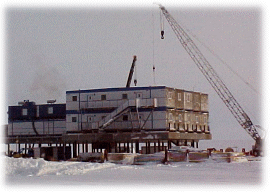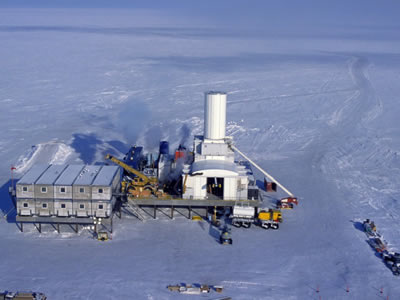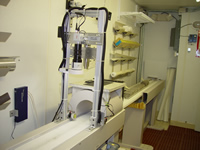In addition to the information provided here, a full listing of project related publications and presentations as well as a listing of funded students can be found in the Methane Hydrate Program Bibliography [PDF].
Final Report - Methane Hydrate Production from Alaskan Permafrost [PDF- 14765KB]
Hot Ice #1 Log File - Hot_Ice_#1 [.zip file containing .las and .txt versions - 599KB]
Topical Report - Core and Fluids Analysis [PDF- 4910KB]
Topical Report - 3D Vertical Seismic Profile Survey [PDF- 27309KB]
Topical Report - Hydrate Reservoir Characterization and Modeling [PDF- 40780KB]
Topical Report - Drilling and Coring Operations [PDF- 5254KB]
Topical Report - Logging Operations [PDF- 3879KB]
Techline- Alaskan Well Targets Gas Hydrate, Produces Wealth of Information - March 2004
Alaska Hydrate Project Overview [PDF-891KB] - October 2003
Project Fact Sheet [PDF-42KB]
Peer-Reviewed Publications
Circone, S., L. Stern, and S. Kirby, 2003, The Role of Water in Hydrate Dissociation, Journal of Physical Chemistry, Volume 108, n. 18, p. 5747-5755.
Millheim, K., J. Kwan, T. Williams, W. Maurer, W. MacDonald, A. Kadaster, T. Thompson, R. Sigal, D. Copeland, D. McGuire, S. Runyon, and B. Liddell, 2005, A project update of methane hydrate production from Alaskan permafrost, in Taylor, C. and J. Kwan, eds., Advances in the Studies of Gas Hydrates, New York, Kluwer Academic/Plenum Publishers, p. 75-85.
Newsham, K., R. Sigal, and J. Kwan, 2005, An Application Used For Correcting Thermal Gradients Below Permafrost Using an Empirical Diffusion Model; Anadarko's Hot Ice #1 Gas Hydrates Case Study, in Taylor, C. and J. Kwan, eds., Advances in the Studies of Gas Hydrates, New York, Kluwer Academic/Plenum Publishers, p. 59-72.
Sigal, R., C. Rai, C. Sondergeld, W. Ebanks, W. Zogg, N. Emery, G. McCardle, W. McLoed, R. Schweizer, and J. Van Eerde, in review, Characterization of potential hydrate bearing reservoirs in the Ugnu and West Sak formations of Alaska’s North Slope, in Collett, T., A. Johnson, C. Knapp and R. Boswell, eds., Natural Gas Hydrates: Energy Resource and Associated Geologic Hazards, The American Association of Petroleum Geologists Hedberg Special Publication.
Stern, L., S. Circone, S. Kirby, and W. Durham, 2001, Anomalous Preservation of Pure Methane Hydrate at 1 atm, Journal of Physical Chemistry, Volume 105, p. 1756-1762.
Stern, L., S. Circone, S. Kirby, and W. Durham, 2001, Reply to Comments on “Anomalous Preservation of Pure Methane Hydrate at 1 atm,” Journal of Physical Chemistry, Volume 106, n. 1, p. 228-230.
Stern, L., S. Circone, S. Kirby, and W. Durham, 2003, Temperature, Pressure, and Compositional Effects on Anomalous or “Self” Preservation of Gas Hydrates, Canadian Journal of Physics, Volume 81, p. 271-283.
Stern, L, S. Circone, S. Kirby, and W. Durham, 2002, New insights into the phenomenon of anomalous or “self” preservation of gas hydrate, Yokohama, Japan, Proceedings, Fourth International Conference on Gas Hydrates, May 19-23, p. 673-677.
Government Reports
Barker, C., 2003, Methane hydrate production form Alaskan permafrost – Coalbed Methane Studies at Hot Ice #1 Gas Hydrate Well, U.S. DOE Topical Report, Contract No. DE-FC26-01NT41331, 7 pp.
Cohen, J., and T. Williams, 2002, Hydrate Core Drilling Tests, Maurer Technology Topical Report, November.
Kadaster, A., B. Liddel, T. Thompson, T. Williams, and M. Nidermayr, 2005, Methane hydrate production form Alaskan permafrost – drilling and coring operations, U.S. DOE-NETL Topical Report, 258 pp., available online (click here - [PDF]).
Kirby, S., S. Circone, and L. Stern, 2003, Methane hydrate production form Alaskan permafrost – Dissociation Rates of Methane Hydrate at Elevated Pressures and of a Quartz Sand-Methane Hydrate Mixture at 0.1 MPa, U.S. DOE-NETL Topical Report, 26 pp.
Kleinberg, R., D. Griffin, and R. Sigal, 2004, Methane hydrate production form Alaskan permafrost – NMR measurements of permafrost: unfrozen water assay, growth habit of ice, and hydraulic permeability of sediments, U.S. DOE-NETL Topical Report, 26 pp.
McGuire, D., S. Runyon, R. Sigal, B. Liddel, T. Williams, and G. Moridis, 2005, Methane hydrate production form Alaskan permafrost – Hydrate reservoir characterization and modeling, U.S. DOE-NETL Topical Report, 20 pp., available online (click here - [PDF]).
McGuire, D., T. Williams, B. Paulsson, and A. Goertz, 2005, Methane hydrate production form Alaskan permafrost – 3D vertical seismic profile survey, U.S. DOE-NETL Topical Report, 30 pp., available online (click here - [PDF]).
Runyon, S., M. Globe, K. Newsham, R. Kleinberg, and D. Griffin, 2005, Methane hydrate production form Alaskan permafrost – logging operations, U.S. DOE-NETL Topical Report, 22 pp., available online (click here - [PDF]).
Sigal, R., K. Newsham, T. Williams, B. Friefeld, T. Kneafsey, C. Sondegard, S. Rai, J. Kwan, S. Kirby, R. Kleinberg, and D. Griffin, 2005, Methane hydrate production form Alaskan permafrost – core and fluid analysis, U.S. DOE-NETL Topical Report, 225 pp., available online (click here - [PDF]).
Sigal, R., 2004, Methane hydrate production form Alaskan permafrost – Hydrate reservoir characterization and modeling – X-ray and Density Log data from the Hot Ice #1 well, U.S. DOE-NETL Topical Report, 6 pp.
Williams, T., K. Millheim, and B. Liddel, 2005, Methane hydrate production form Alaskan permafrost, U.S. DOE-NETL Final Report, Contract No. DE-FC26-01NT41331, available online (click here - [PDF]).
Other Publications
Kirby, S., S. Circone, L. Stern, and J. Pinkston, 2004, Self-regulating effects of gas hydrate decomposition relevant to natural gas production models, U.S. DOE-NETL Fire in the Ice Newsletter, Summer.
Kirby, S., L. Stern, S. Circone, and J. Pinkston, 2004, Hydrate decomposition under scrutiny: U.S. DOE-NETL Fire in the Ice Newsletter, Winter.
Presentations
Barker, C., J. Clough, S. Roberts, A. Clark, and B. Fisk, 2003, Physical Limitations on Coalbed Gas Content of Low Rank Coals, North Slope, Alaska, An Apparent Widespread Depletion of Coalbed Gas in Permafrost, Billings, MT, 18th International Low-Rank Fuels Symposium, June 24-26.
Kadaster, A., K. Millheim, and T. Thompson, 2005, The Planning and Drilling of Hot Ice #1 – Gas Hydrate Exploration Well in the Alaskan Arctic, Amsterdam, The Netherlands, SPE/IADC Drilling Conference & Exhibition, February 23-25.
Kadaster, A., and K. Millheim, 2004, Onshore Mobile Platform: A Modular Platform for Drilling and Production Operations in Remote and Environmentally Sensitive Areas, Dallas, TX, IADC/SPE Drilling Conference, March 2-4.
McGuire, D., S. Runyon, T. Williams, B. Paulsson, A. Goertz, and M. Karrenbach, 2004, Gas Hydrate Exploration with 3D VSP Technology, North Slope, Alaska, Denver, CO, Society of Exploration Geophysicists 74th Annual Meeting, October 11-15.
McGuire, D., S. Runyon, T. Williams, and R. Sigal, 2004, Integration of VSP Seismic Data with Core and Well Log Data to Investigate Lateral Variations of Potential Hydrate-Bearing Sands, Alaska North Slope, Vancouver, BC, Canada, The American Association of Petroleum Geologists Hedberg Research Conference, September 12-16.
Millheim, K., J. Kwan, and B. Maurer, 2002, A Field Oriented Natural Gas Hydrate Research Project for the Alaska North Slope – Resource Evaluation and Possible Testing, Orlando, FL, 223rd American Chemical Society National Meeting, April 9.
Millheim, K., 2002, Methane Hydrate Production from Alaska Permafrost, Houston, TX, The American Association of Petroleum Geologists Hydrate Meeting, March 12.
Sigal, R., C. Rai, C. Sondergeld, W. Ebanks, W. Zogg, and R. Kleinberg, 2004, Characterization of Potential Hydrate Bearing Reservoirs in the Ugnu and West Sak Formations of Alaska’s North Slope, Vancouver, BC, Canada, The American Association of Petroleum Geologists Hedberg Research Conference, September 12-16.
Stern, L., S. Circone, S. Kirby, and W. Durham, 2002, New insights into the phenomenon of anomalous or “self” preservation of gas hydrates, Newfoundland, Canada, International Symposium on the Physics and Chemistry of Ice, July 14-19.
Williams, T., B. Liddell, A. Kadaster, and T. Thompson, 2004, Hot Ice Well No. 1 – Well Planning, Operations and Results of the First Dedicated Gas Hydrate Well in the Alaskan Arctic, Vancouver, BC, Canada, The American Association of Petroleum Geologists Hedberg Research Conference, September 12-16.
Williams, T., 2003, Methane Hydrate Production – Application of Arctic Hydrate Research to Deep Water, Houston, TX, American Association of Drilling Engineers, Deep Water Quarterly Forum, February 11.






